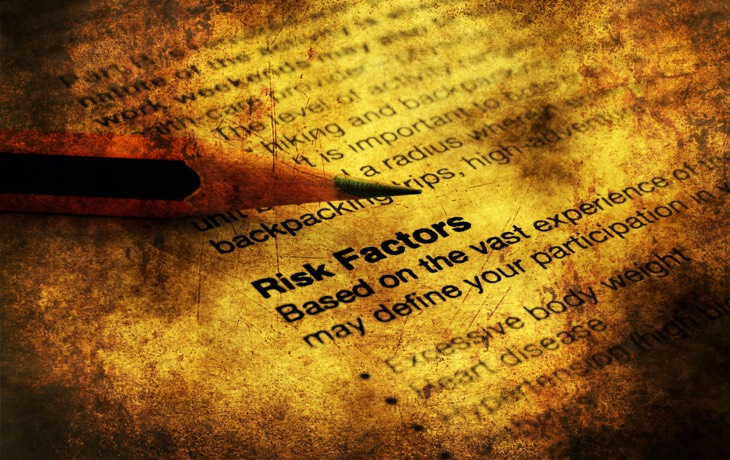States may be reopening, but the COVID-19 pandemic is far from over. In fact, some studies show cases are likely to rise, and more than ever Americans are now at risk of contracting COVID-19.
Given that everyone’s odds of having a run-in with the coronavirus just went up, people are beginning to wonder how much risk they personally face from the disease — not just risk of death (though that’s a valid concern), but the risk of suffering some of the nastier, potentially long-term side effects of surviving a severe case of COVID-19. Furthermore, Americans want to know if there are any risk factors that they can actually control so that if they do catch the bug they’re more likely to be able to fight it off safely.
Fortunately, we know a lot more than we did a few months ago about the relevant risk factors. Several recent studies have looked into risk factors and comorbidities of COVID-19, and we can look to those to assess how much danger we may be in and what, if anything, we can do to change that. (“Comorbidities” for coronavirus are health conditions that are present most often when people are infected with it.) Most of us are already familiar with some of these conditions, just from the news coverage, e.g., men are more likely to get COVID-19, as are the elderly and immunocompromised.
But when we examined the New York City hospitalization and daily death data, we found some surprises. Some of these risk factors are out of our control, while others are not. Either way, as the spread continues, it’s important to be informed about where the highest risks lay.
Age is still the top risk factor
Before we get into more detail, we should make one thing completely clear. Age is still the top risk factor, and its effect is much larger than the independent effect of these other factors. The difference in COVID-19 fatality rates between young adults and the very elderly is nearly a factor of 100, dwarfing the effects of other risk factors. The elderly are still the population most at risk, and these other factors are nuances to lay on top of that core understanding.
The comorbidity top 10
Of the total people who’ve died of COVID-19 in New York State, 89.5% had at least one comorbidity, according to the most recent mortality data. The top 10 comorbidities (as of this reporting) include:
- Hypertension (12,060 fatalities)
- Diabetes (7,966 fatalities)
- High cholesterol (4,669 fatalities)
- Dementia (2,822 fatalities)
- Coronary Artery Disease (2,594 fatalities)
- Renal Disease (2,348 fatalities)
- COPD (1,989 fatalities)
- Atrial Fibrillation (1,680 fatalities)
- Cancer (1,617 fatalities)
- Stroke (1,460 fatalities)
In the New York City hospitalization study, we get additional data not included in the New York State fatality record, such as smoking and obesity. Doctors examined 5700 patients’ data to get a sense of the factors behind their experience with COVID-19.
The most common comorbidities the doctors found:
- Hypertension (3026 patients, 56.6%)
- Obesity (1737 patients, 41.7%)
- Diabetes (1808 patients, 33.8%)
Scientists used the Charlson Comorbidity Index to measure the comorbidity burden of the patients. The median score was 4 points, which means hospitalized COVID-19 patients with these conditions already only have a 53% chance of surviving the next 10 years. The researchers on the study conclude that that’s a “significant comorbidity burden.”
How to interpret ‘comorbidities’ for COVID-19
For our purposes, we want to know if COVID-19 is disproportionately impacting people with the conditions listed in the previous section. But if we look at this data on its own, it’s impossible to say if any of these conditions make it more likely for someone to suffer severe COVID-19 or die from it. There are two reasons why we can’t just take the list above and jump straight to assessing risk:
- Anything that is common in a given population will also be common among those who contract and die of COVID-19.
- Some qualities that are overrepresented in a group of COVID-19 patients may not have any medical significance in and of themselves, but for various reasons, they just happen to appear alongside medical factors that actually do matter.
As an example of the first reason above, if 50% of a given population has brown hair, it would be reasonable for 50% of COVID-19 patients in that population to also have brown hair. That wouldn’t mean brown hair was a risk factor for COVID-19. So we have to take the prevalence of each condition in the wider population into account when sorting out how much it impacts the severity of a bad case of coronavirus.
Scientists correct for this by determining hazard ratios. A hazard ratio measures the extent to which someone with a particular property is more likely to experience a particular hazard. These can be further adjusted for age and other factors. The only paper doing this kind of thing systematically in COVID-19 is an analysis of a Chinese cohort from March, but we can expect more data like this to arrive. We’ll explore these and other hazard ratio results in the rest of this article.
As for the second reason, consider the fact that Black Americans are more likely to contract and die of COVID-19 than Americans of other races. At this point in the pandemic, 18% of the New Yorkers who’ve died of COVID-19 have been black. Meanwhile, black people make up just 9% of the New York City population. In some other states, black people are even 6 or 7 times more likely to die of COVID-19 than whites. But that correlation doesn’t mean causality—that race makes some people more likely to die of COVID-19. Rather, we suspect that systemic inequalities are at the root of the difference in outcomes, here.
Comorbidities and mortality: high blood pressure, high cholesterol, and diabetes
Hypertension (high blood pressure) tops the comorbidity list in both New York State deaths and New York City hospitalizations. Over half of patients hospitalized have this comorbidity, but as careful analyses point out, hypertension is also very common. Somewhere around 45% of older folks have hypertension, so it’s too early to say whether hypertension actually increases COVID-19 risk. If COVID-19 does disproportionately impact those with hypertension, the effect may be small. It could be between 1.2 and 1.3 fold.
There is also some evidence that the medication taken by many people with hypertension might be protective, although nobody should change medications based on such flimsy evidence.
Hyperlipidemia, the third comorbidity on New York State’s top 10, is another term for high cholesterol. In New York State, 21.5% of people who’ve died of COVID-19 had hyperlipidemia. Meanwhile, 10-13% of the general population has hyperlipidemia. But in the over 65 population, 25% of men and 42% of women have this condition. Hence, without a careful analysis matching by age, we can’t say that high cholesterol is a major risk factor for COVID-19.
Of the people who died in New York, 37% had diabetes. In the hospitalization study, nearly 34% of those hospitalized had diabetes. Meanwhile, just 20.3% of 65-74-year-old New Yorkers have diabetes. In China, where the incidence of diabetes is even lower, the data suggests diabetics are around three times more likely to get COVID-19. While 2.3% of the Chinese population has diabetes, 7.3% of COVID-19 patients had diabetes. No matter which numbers you take as a base, people with diabetes are overrepresented among severe COVID-19 cases and deaths.
Respiratory conditions aren’t a huge threat
Contrary to what many physicians guessed early on, the actual data suggest people with diseases of the lung such as asthma and COPD are at average or lower risk of contracting COVID-19. Both diseases appear to be underrepresented in patients diagnosed with COVID-19. While COPD is currently number seven on New York State’s comorbidity fatality list, with 8.9% of cases, an estimated 11-18% of over 65-year-olds have this condition.
Data from late March shows that 8.5% to 10.2% of American COVID-19 patients had asthma, COPD, or another chronic respiratory disease. Meanwhile, 11.3% of Americans suffer from these respiratory illnesses. It’s possible that inhaled treatments like corticosteroids suppress the coronavirus and prevent COVID-19 from developing. (That’s a very early finding and isn’t currently influencing how doctors treat patients with COVID-19.)
We thought smoking could be a risk factor—but maybe not
Early on in the coronavirus pandemic, both common sense and the CDC predicted that smoking would increase the risk of severe disease from a respiratory virus. Now, however, research shows that smoking does not seem to significantly increase the risk of being hospitalized for COVID-19. In fact, some suggest smoking is protective against the coronavirus.
One French study showed that while a quarter of the population smokes, only 4.4% of COVID-19 patients were smokers, and a large meta-analysis of several studies in China concludes that while a quarter of the population smokes, only 7.3% of hospitalized COVID-19 were active smokers.
It is, however, possible that smokers are at risk of more severe outcomes. Data from the CDC shows that only 1.3% of 74,439 US COVID-19 cases were current smokers. Former smokers made up just 2.3% of those cases. That’s far less than the number of smokers counted in the US population, but there may be missing data on smoking in many COVID-19 cases. Meanwhile, the New York hospitalization study reports that 84.4% of hospitalized cases were never smokers.
There are caveats, however. Certainly, nobody would go as far as recommending you start smoking. I wouldn’t buy a nicotine patch, either, as it isn’t clear that nicotine is the reason why smoking seems to be protective.
Recent studies show BMI could be a risk factor
In April, New York University researchers published a letter in Clinical Infectious Diseases that said obesity was a risk factor for the severity of disease in COVID-19 patients, especially in patients under 60 years old. The researchers examined 3,615 COVID-19 patients admitted to the University hospital in March. They found that young (under 60) patients with body mass indexes (BMI) between 30 and 34 were twice as likely to be admitted and 1.8 times as likely to require ICU treatment. That’s compared to patients with BMIs under 30. For patients in the same age group with more severe obesity, a BMI over 35, the risk was 2.2 higher to be hospitalized, and 3.6 times higher to be admitted to the ICU.
The results were particularly striking because patients under 60 have been seen as a low-risk demographic for COVID-19 so far.
Importantly, obesity doesn’t appear to be a factor in COVID-19 hospitalization or diagnosis. The patients in the study largely matched up with the larger American population. The CDC estimates that 42.4% of Americans are obese. The NYU researchers found that 36% of hospitalized patients had BMIs greater than 30. Since obesity also varies by race, age, and gender, a proper comparison requires further studies and no claim about obesity was made.
It’s also worth noting that the NYU letter doesn’t share whether the patients who ended up in ICU also had the comorbidities we’ve already discussed like diabetics and cardiovascular disease.
Unfortunately, the New York State mortality registry doesn’t list smoking, BMI, or obesity, so we don’t know if those who’ve died in New York State had any of those risk factors.


You are reporting the comment """ by on